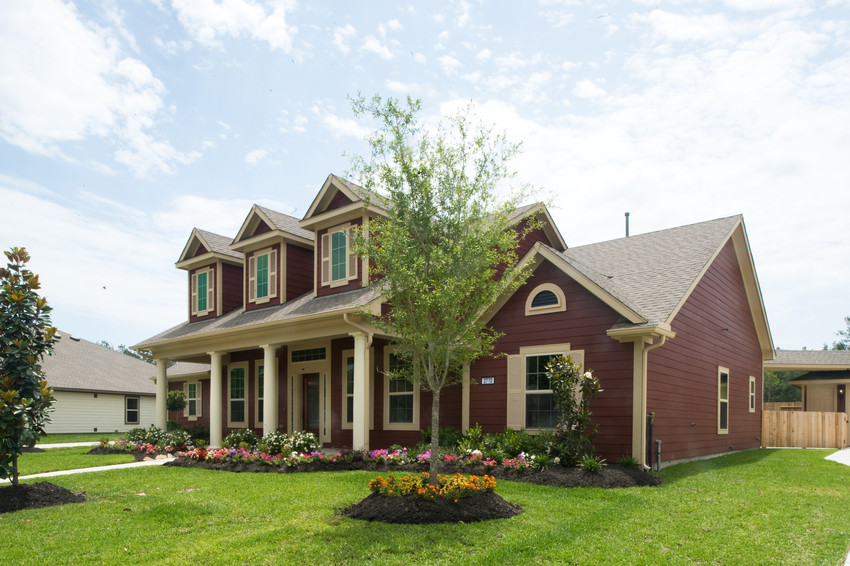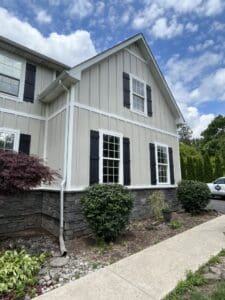What You Need to Know About Hardie Board Siding

When you need new siding, the first step in the process is choosing the right replacement material for your home. James Hardie siding is one of the most popular siding options in the greater Philadelphia area, as it can withstand our climate extremes. Below, learn what you need to know about Hardie Board siding so you can decide whether it’s the right choice for your exterior.
If you’re interested in learning more about our siding replacement services or you have questions for our exterior remodeling experts, please don’t hesitate to call us at 888-944-6493 or contact us online.
What Is Hardie Board Siding?
In the simplest terms, Hardie Board siding is a type of fiber cement siding material made by James Hardie. It’s made from a combination of cellulose fibers, Portland cement, and sand, which results in a material that looks like wood siding but is much more durable.
Different Types of Hardie Board Siding
One of the many reasons our customers love Hardie Board siding is that it’s available in countless design and color options. This allows you to create the exterior of your dreams that is both beautiful and durable.
Here’s a closer look at the different Hardie Board styles to consider installing.
HardiePlank® Lap Siding
This is one of the most popular Hardie Board options, as it’s a classic, horizontal plank that complements just about any home style. It comes in four main options:
- Beaded Smooth, which is a clean and modern look
- Select Cedarmill, which mimics the look of wood grain
- Beaded Cedarmill, which has a more pronounced wood grain texture
- Smooth, which is a sleek and polished look
HardiePanel® Vertical Siding

Another popular option, this vertical siding is beautiful on its own or used as an accent with the HardiePlank® Lap Siding. It’s available in the following styles:
- Select Cedarmill, which features a wood grain texture
- Sierra 8, which features texture and linear details for a beautiful design
- Smooth, which is sanded down for a modern finish
- Stucco, which mimics the look of stucco, without any of the durability concerns
Hardie® Architectural Panel Products
This line of Hardie Board includes a variety of trims and panels to create a beautiful home design that will look great for years to come. It comes in the following options:
- Fine Sand, which has a nice smooth surface
- Fine Sand-Grooved, which features grooves on the surface for an eye-catching visual effect
- Mounded Sand, which has a sand-like texture
- Seagrass, which looks similar to seagrass and is a popular choice for coastal homes
HardieShingle® Siding

If you drive around your neighborhood, it probably won’t take you long to notice a home with shingle sidings like the one in this collection. This option comes in two styles:
- Straight Edge Panel, which offers a clean yet rustic look
- Staggered Edge Panel, which features shingles of different lengths and sizes for a cottage-inspired look
Benefits of Hardie Board Siding
We recommend Hardie Board siding to so many of our customers because we believe it’s one of the best siding materials on the market. Here are some of the benefits you can enjoy when choosing this material for your home:
- Durability: Hardie Board siding can withstand weather extremes like heavy wind, rain, snow, hail, and ice, making it a perfect choice for our Southeastern Pennsylvania climate.
- Pest resistance: Critters like woodpeckers and termites won’t create holes in your Hardie Board siding like they might with other siding materials.
- Water resistance: Unlike wood siding and stucco, which are prone to moisture issues, Hardie Board siding is highly resistant to water damage.
- Low maintenance: It’s easy to care for Hardie Board siding. Simply clean it a few times per year with a garden hose and gentle brush to remove dirt and debris.
- Fade resistance: Since Hardie Board siding is made to withstand UV exposure, it’s less likely to fade compared to some other siding materials.
How Hardie Board Compares to Other Siding Materials
| SIDING COMPARISON | JAMES HARDIE | CERTAINTEED/MASTIC | EVERLAST | LP SMARTSIDE |
| MATERIALS | Composed of cement, sand and cellulose fibers. | Composed of polyvinyl chloride, aka PVC. | Composite inorganic minerals, polymer resin, acrylic colorants | Made from engineered wood with manufactured materials |
| DURABILITY | Very Durable | Least Durable | Very Durability | Most Durable |
| THICKNESS (LAP) | ~1/4″ | ~0.05″ | ~1/4″ | ~1/4″ |
| TEXTURE | Wood like and Smooth | Wood like | Wood like | Wood |
| COLOR | 18 Standard Colors | 20 to 30 Standard Colors | 15 Standard Colors | 16 Standard Colors |
| STANDARD LAP SIZES | 8.25″ (Custom Sizes available) | 4″, 5″ | 7″, 4.5″ | 5.84″, 6.84″, 7.84″, 11.84″ |
| AVAILABLE SIDING TYPES | Lap, Vertical, Shingle, Special | Lap, Vertical, Shingle | Lap, Vertical | Lap, Vertical |
| INSTALLATION DIFFICULTY | Complex | Easy | Moderate | Moderate |
| MAINTENANCE | Some | Little to None | Little to None | Some |
| PAINTABLE | Yes | No | Yes but Not Recommended | Yes |
| COST | $$($) | $ | $$$ | $$ |
| WARRANTY | 30 YEAR NO-PRORATED | LIMITED LIFETIME | LIMITED LIFETIME | 50 YEAR LIMITED |
| MHX INSIGHT | A beautiful siding system with many installation requirements. Extensive knowledge and experience is required to install the system to meet the manufacturer warranty. Ongoing maintenance required. Offers many different siding types and options to build a custom design. | The most popular siding system in the Northeast and a cost effective solution. Less durable than other siding systems. Easy to repair. No maintenance required. | It is a great vinyl siding option. Little to no maintenance required. A complete siding system with the built-in window and door trims. The best waterproofing siding system. A limited availability and potential supply issues. | It is an excellent wood siding system. Some maintenance required. Very similar to the James Hardie system. The most durable siding system of all. A limited availability and potential supply issues in the Northeast region. It provides an authentic wood siding appearance. |
Hardie Clearance Requirements
James Hardie siding, known for its durability and aesthetic appeal, often comes with specific clearance requirements to ensure proper installation and long-term performance. Clearance requirements for James Hardie siding typically involve maintaining a specified distance between the siding and surrounding elements such as windows, doors, roof lines, and other adjacent structures. These clearances are crucial for allowing proper expansion and contraction of the siding material with changes in temperature and humidity, minimizing the risk of warping or buckling.
Additionally, maintaining proper clearances facilitates adequate ventilation and drainage, preventing moisture-related issues that could compromise the integrity of the siding. Adhering to James Hardie’s clearance guidelines is essential for achieving optimal performance, longevity, and maintaining the manufacturer’s warranty. Professional installation following these specifications ensures that the siding not only enhances the visual appeal of your home but also withstands the test of time in various weather conditions. Check out the various clearance requirements below:

Schedule Hardie Board Siding With The Experts
Now that you’ve learned more about what you need to know about Hardie Board siding, we hope you feel more confident choosing it for your upcoming siding replacement project. No matter which Hardie Board style appeals to you most, our experts at MHX Designs are here to complete the installation for you with ease. We truly believe in our product, which wins out in many of the siding brand comparisons that homeowners want. If you’re interested in learning more about how we can transform your exterior or you’d like to receive a quote for your Hardie Board siding installation, please call us at 888-944-6493 or contact us online.
